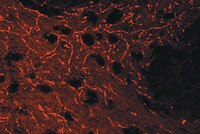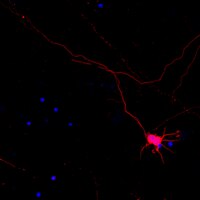Molecular and functional diversity of GABA-A receptors in the enteric nervous system of the mouse colon.
Seifi, M; Brown, JF; Mills, J; Bhandari, P; Belelli, D; Lambert, JJ; Rudolph, U; Swinny, JD
The Journal of neuroscience : the official journal of the Society for Neuroscience
34
10361-78
2014
Show Abstract
The enteric nervous system (ENS) provides the intrinsic neural control of the gastrointestinal tract (GIT) and regulates virtually all GI functions. Altered neuronal activity within the ENS underlies various GI disorders with stress being a key contributing factor. Thus, elucidating the expression and function of the neurotransmitter systems, which determine neuronal excitability within the ENS, such as the GABA-GABAA receptor (GABAAR) system, could reveal novel therapeutic targets for such GI disorders. Molecular and functionally diverse GABAARs modulate rapid GABAergic-mediated regulation of neuronal excitability throughout the nervous system. However, the cellular and subcellular GABAAR subunit expression patterns within neurochemically defined cellular circuits of the mouse ENS, together with the functional contribution of GABAAR subtypes to GI contractility remains to be determined. Immunohistochemical analyses revealed that immunoreactivity for the GABAAR gamma (γ) 2 and alphas (α) 1, 2, 3 subunits was located on somatodendritic surfaces of neurochemically distinct myenteric plexus neurons, while being on axonal compartments of submucosal plexus neurons. In contrast, immunoreactivity for the α4-5 subunits was only detected in myenteric plexus neurons. Furthermore, α-γ2 subunit immunoreactivity was located on non-neuronal interstitial cells of Cajal. In organ bath studies, GABAAR subtype-specific ligands had contrasting effects on the force and frequency of spontaneous colonic longitudinal smooth muscle contractions. Finally, enhancement of γ2-GABAAR function with alprazolam reversed the stress-induced increase in the force of spontaneous colonic contractions. The study demonstrates the molecular and functional diversity of the GABAAR system within the mouse colon providing a framework for developing GABAAR-based therapeutics in GI disorders. | 25080596
 |
A streamlined method for rapid and sensitive chromatin immunoprecipitation.
Michael L Sikes,Justin M Bradshaw,Wendell T Ivory,Jessica L Lunsford,Ruth E McMillan,Clayton R Morrison
Journal of immunological methods
344
2009
Show Abstract
We report a streamlined procedure to efficiently carry samples from chromatin to qPCR-compatible DNA in as little as 4 h. We use this streamlined ChIP to quantify histone H3 modifications at active (cad) and repressed (T early alpha) promoters in a Rag1-deficient pro-T cell line after 1-2 h IP. We further show that the protocol readily quantified histone modifications in chromatin from 10(4) Rag-deficient DN thymocytes. Taken together, these data outline a simple, cost-effective procedure for efficient ChIP analysis. Full Text Article | 19328803
 |
Identification of the cannabinoid receptor type 1 in serotonergic cells of raphe nuclei in mice.
M Häring, G Marsicano, B Lutz, K Monory
Neuroscience
146
1212-9
2007
Show Abstract
The endocannabinoid system (ECS) possesses neuromodulatory functions by influencing the release of various neurotransmitters, including GABA, noradrenaline, dopamine, glutamate and acetylcholine. Even though there are studies indicating similar interactions between the ECS and the serotonergic system, there are no results showing clear evidence for type 1 cannabinoid receptor (CB1) location on serotonergic neurons. In this study, we show by in situ hybridization that a low but significant fraction of serotonergic neurons in the raphe nuclei of mice contains CB1 mRNA as illustrated by the coexpression with the serotonergic marker gene tryptophane hydroxylase 2, the rate limiting enzyme for the serotonin synthesis. Furthermore, by double immunohistochemistry and confocal microscopy, we were able to detect CB1 protein on serotonergic fibers and synapses expressing the serotonin uptake transporter in the hippocampus and the amygdala. Our findings indicate that the CB1-mediated regulation of serotonin release can depend in part on a direct cross-talk between the two systems at single cell level, which might lead to functional implications in the modulation of emotional states. | 17383106
 |
Rat brain serotonin neurones that express neuronal nitric oxide synthase have increased sensitivity to the substituted amphetamine serotonin toxins 3,4-methylenedioxymethamphetamine and p-chloroamphetamine.
D J De Silva, S J French, N Y Cheung, A K Swinson, C Bendotti, M Rattray
Neuroscience
134
1363-75
2005
Show Abstract
Substituted amphetamines such as p-chloroamphetamine and the abused drug methylenedioxymethamphetamine cause selective destruction of serotonin axons in rats, by unknown mechanisms. Since some serotonin neurones also express neuronal nitric oxide synthase, which has been implicated in neurotoxicity, the present study was undertaken to determine whether nitric oxide synthase expressing serotonin neurones are selectively vulnerable to methylenedioxymethamphetamine or p-chloroamphetamine. Using double-labeling immunocytochemistry and double in situ hybridization for nitric oxide synthase and the serotonin transporter, it was confirmed that about two thirds of serotonergic cell bodies in the dorsal raphé nucleus expressed nitric oxide synthase, however few if any serotonin transporter immunoreactive axons in striatum expressed nitric oxide synthase at detectable levels. Methylenedioxymethamphetamine (30 mg/kg) or p-chloroamphetamine (2 x 10 mg/kg) was administered to Sprague-Dawley rats, and 7 days after drug administration there were modest decreases in the levels of serotonin transporter protein in frontal cortex, and striatum using Western blotting, even though axonal loss could be clearly seen by immunostaining. p-Chloroamphetamine or methylenedioxymethamphetamine administration did not alter the level of nitric oxide synthase in striatum or frontal cortex, determined by Western blotting. Analysis of serotonin neuronal cell bodies 7 days after p-chloroamphetamine treatment, revealed a net down-regulation of serotonin transporter mRNA levels, and a profound change in expression of nitric oxide synthase, with 33% of serotonin transporter mRNA positive cells containing nitric oxide synthase mRNA, compared with 65% in control animals. Altogether these results support the hypothesis that serotonin neurones which express nitric oxide synthase are most vulnerable to substituted amphetamine toxicity, supporting the concept that the selective vulnerability of serotonin neurones has a molecular basis. | 16054768
 |
Chromatin architecture near a potential 3' end of the igh locus involves modular regulation of histone modifications during B-Cell development and in vivo occupancy at CTCF sites.
Garrett, FE; Emelyanov, AV; Sepulveda, MA; Flanagan, P; Volpi, S; Li, F; Loukinov, D; Eckhardt, LA; Lobanenkov, VV; Birshtein, BK
Molecular and cellular biology
25
1511-25
2005
Show Abstract
The murine Igh locus has a 3' regulatory region (3' RR) containing four enhancers (hs3A, hs1,2, hs3B, and hs4) at DNase I-hypersensitive sites. The 3' RR exerts long-range effects on class switch recombination (CSR) to several isotypes through its control of germ line transcription. By measuring levels of acetylated histones H3 and H4 and of dimethylated H3 (K4) with chromatin immunoprecipitation assays, we found that early in B-cell development, chromatin encompassing the enhancers of the 3' RR began to attain stepwise modifications typical of an open conformation. The hs4 enhancer was associated with active chromatin initially in pro- and pre-B cells and then together with hs3A, hs1,2, and hs3B in B and plasma cells. Histone modifications were similar in resting splenic B cells and in splenic B cells induced by lipopolysaccharide to undergo CSR. From the pro-B-cell stage onward, the approximately 11-kb region immediately downstream of hs4 displayed H3 and H4 modifications indicative of open chromatin. This region contained newly identified DNase I-hypersensitive sites and several CTCF target sites, some of which were occupied in vivo in a developmentally regulated manner. The open chromatin environment of the extended 3' RR in mature B cells was flanked by regions associated with dimethylated K9 of histone H3. Together, these data suggest that 3' RR elements are located within a specific chromatin subdomain that contains CTCF binding sites and developmentally regulated modules. | 15684400
 |
Decreased 5-HT transporter mRNA in neurons of the dorsal raphe nucleus and behavioral depression in the obese leptin-deficient ob/ob mouse.
M Collin, M L Håkansson-Ovesjö, I Misane, S O Ogren, B Meister
Brain research. Molecular brain research
81
51-61
2000
Show Abstract
The neurotransmitter serotonin (5-hydroxytryptamine; 5-HT) is an important regulator of feeding behavior. A hypothalamic site of action for 5-HT in body weight control is supported by the presence of 5-HT receptors in hypothalamic regions which are intimately associated with regulation of food intake. In the present study we have investigated whether there may be an interaction between the hormone leptin, an adipose tissue-derived cytokine signaling factor that inhibits food intake and lowers body weight, and the brain serotonergic system. Immunohistochemical analysis of colchicine-treated rats showed colocalization of 5-HT transporter- and leptin receptor-immunoreactivity in cell bodies of the dorsal raphe nucleus, suggesting that dorsal raphe neurons are targets for circulating leptin. Levels of 5-HT transporter mRNA expression were compared in neurons of the dorsal raphe nucleus of obese leptin-deficient ob/ob mice and their lean littermates using in situ hybridization. 5-HT transporter mRNA levels were significantly down-regulated in neurons of the dorsal raphe nucleus of obese ob/ob mice as compared to lean control mice. Behavioral analysis showed that obese ob/ob mice had significantly lower locomotor activity and exhibited increased immobility in Porsolt's test, a model for depression. Taken together, these results suggest that serotonergic cell bodies in the rodent dorsal raphe nucleus possess leptin receptors and that the serotonergic system, as reflected by expression levels of 5-HT transporter mRNA, is down-regulated in the obese behaviorally depressed ob/ob mouse. | 11000478
 |














